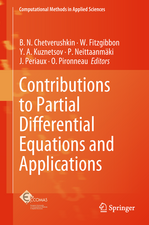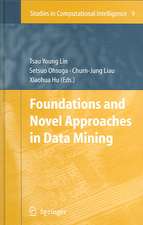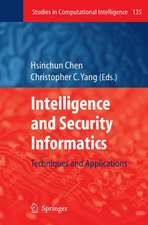The finite element method in the 1990’s: A Book Dedicated to O.C. Zienkiewicz
Editat de Eugenio Onate, J. Periaux, A. Samuelssonen Limba Engleză Paperback – 23 aug 2014
Preț: 657.39 lei
Preț vechi: 773.41 lei
-15% Nou
Puncte Express: 986
Preț estimativ în valută:
125.80€ • 130.60$ • 104.90£
125.80€ • 130.60$ • 104.90£
Carte tipărită la comandă
Livrare economică 24 martie-07 aprilie
Preluare comenzi: 021 569.72.76
Specificații
ISBN-13: 9783662103289
ISBN-10: 3662103281
Pagini: 644
Ilustrații: 638 p. 218 illus., 18 illus. in color.
Dimensiuni: 155 x 235 x 38 mm
Greutate: 0.89 kg
Ediția:Softcover reprint of the original 1st ed. 1991
Editura: Springer Berlin, Heidelberg
Colecția Springer
Locul publicării:Berlin, Heidelberg, Germany
ISBN-10: 3662103281
Pagini: 644
Ilustrații: 638 p. 218 illus., 18 illus. in color.
Dimensiuni: 155 x 235 x 38 mm
Greutate: 0.89 kg
Ediția:Softcover reprint of the original 1st ed. 1991
Editura: Springer Berlin, Heidelberg
Colecția Springer
Locul publicării:Berlin, Heidelberg, Germany
Public țintă
ResearchCuprins
Content.- Section 1 Personal Addresses.- On OCZ.- Our First Encounter.- Personal Address for Olek C. Zienkiewicz at the Occasion of his 70th Birthday.- University College of Swansea : 1962–1966.- Section 2 Structural and Solid Mechanics.- A New Boundary-Type finite element for 2D- and 3D-Elastic Solids.- New Trends in Hybrid-Treffz p-Element approach.- Thermo Mechanical coupling in Elasto-Plastic analysis.- A variational formulation of Shallow Shells.- Stiffness identification of structural components by mixed experimental and numerical techniques.- Rigid finite element method in structural analysis.- Seismic finite element analysis of masonry buildings reinforced with ferrocement.- Are there any new elements?.- Generalized plasticity modelling of saturated sand Behaviour under Earthquake Loading.- Adaptive mesh refinement techniques for structural problems.- Remarks on selection of stresses to suppress zero energy deformation modes in hybrid element formulations.- Finite element adaptivity in dynamics and elastoplasticity.- On the use of finite elements in fast transient dynamics.- Industrial use of liquefaction analysis in 1980s.- Discrete limit analysis of reinforced concrete structures using rigid Bodies-spring models.- Error analysis of staggered predictor-corrector scheme for consolidation of porous media.- Optimal shape design under transient dynamic loading.- A finite element method for dynamic contact problems.- The Taylor impact test problem revisiting the standard 2-Node rod finite element.- One dimensional Transient dynamic analysis with adaptive mesh refinement.- Incremental finite element analysis of nonlinear structural design sensitivity problems.- A Comparison of Two variational formulations for Rubber-Like materials.- Convergence of theNewton-Raphson method in Elastic-Plastic-Softening structural dynamics.- Some recent research on the Non-Linear analysis of Shells.- Constitutive modelling of geomaterials with account for deformational anisotropy.- The Co-Rotational approach to substructuring for flexible multibody analysis.- Reduced basis technique for calculating sensitivity derivatives of the nonlinear structural response.- A numerical approach to the exact finite element linear Buckling analysis of structures.- An assessment of the cosserat continuum through the finite element simulation of a strain localisation problem.- Simulated head impacts with upper interior structures using rigid and anatomic brain models.- Mass Lumping by spectral Matching.- Vibrations of Fluid-Structure coupled systems.- Biomechanics needs fem.- Section 3 Fluid Mechanics.- Numerical methods for the Helmholtz equation with Non-Reflecting Boundary conditions in exterior domains.- Finite element study of shock induced cavitation.- Generalised mesh and adaptivity techniques for computational fluid dynamics.- A fictitious domain method for the incompressible Navier-Stokes equations.- Simple elements and linelets for incompressible flows.- Finite element analysis of Tsunami Wave propagation using optimal Mesh.- Finite element modelling of mould filling.- The computation of aerodynamic flows using unstructured meshes.- On the penalty method for incompressible fluids.- Section 4 General Applications of the Finite Element Method.- The finite element method in the 1990’s: A personal perspective.- Concerning the future of civil engineering.- Reflections on technical journal editing.- The quench propagation in superconducting magnets. A finite element solution.- Finite elements and magnetic scalar potentials.- Unity and Hierarchyin modelling. Olek Zienkiewicz’s contributions and impact.- A fully consistent formulation of early-time approximations for acoustic media.- Application of a polydescriptive approach: bond graphs and finite elements to design analysis.- A unified approach to the dynamic analysis of soils as multiphase media.- Section 5 Mathematical Aspects of the Finite Elemend Method.- A note on the derivation of weak forms.- The individual element test revisited.- Dualities in minimum surfaces.- Multidisciplinary finite element modeling and simulation of Aerospace vehicles.- A new approach to stability analysis of partitioned systems.- Further tests on the derivative recovery technique and a posteriori error estimator.- Olek and a mathematician.- Remarks on approximate controllability for parabolic systems.- On a new feasible directions solution approach in constrained optimization.- Hierarchical or domain decomposition preconditioning for the P-Version finite element method.





























